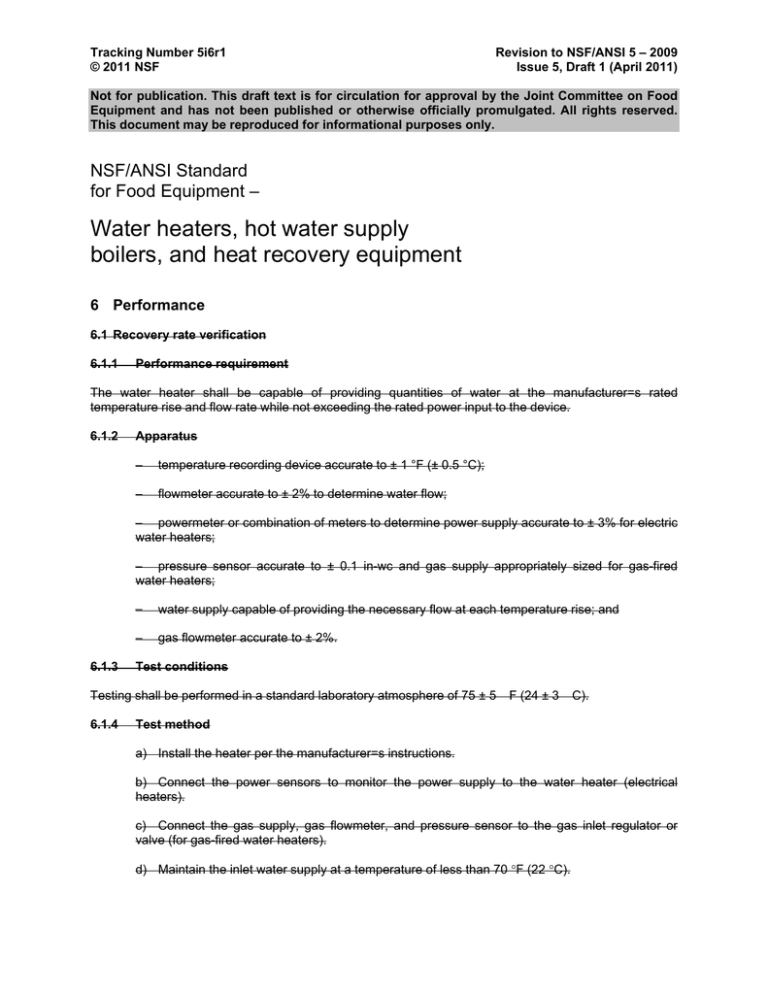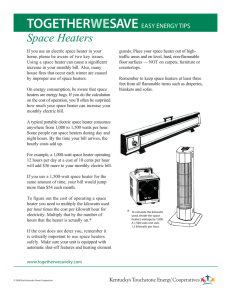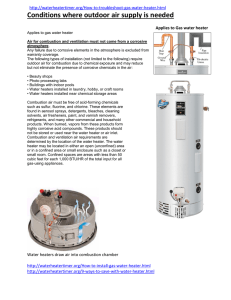
Tracking Number 5i6r1
© 2011 NSF
Revision to NSF/ANSI 5 – 2009
Issue 5, Draft 1 (April 2011)
Not for publication. This draft text is for circulation for approval by the Joint Committee on Food
Equipment and has not been published or otherwise officially promulgated. All rights reserved.
This document may be reproduced for informational purposes only.
NSF/ANSI Standard
for Food Equipment –
Water heaters, hot water supply
boilers, and heat recovery equipment
6 Performance
6.1 Recovery rate verification
6.1.1
Performance requirement
The water heater shall be capable of providing quantities of water at the manufacturer=s rated
temperature rise and flow rate while not exceeding the rated power input to the device.
6.1.2
Apparatus
–
temperature recording device accurate to ± 1 °F (± 0.5 °C);
–
flowmeter accurate to ± 2% to determine water flow;
– powermeter or combination of meters to determine power supply accurate to ± 3% for electric
water heaters;
– pressure sensor accurate to ± 0.1 in-wc and gas supply appropriately sized for gas-fired
water heaters;
6.1.3
–
water supply capable of providing the necessary flow at each temperature rise; and
–
gas flowmeter accurate to ± 2%.
Test conditions
Testing shall be performed in a standard laboratory atmosphere of 75 ± 5
6.1.4
F (24 ± 3
C).
Test method
a) Install the heater per the manufacturer=s instructions.
b) Connect the power sensors to monitor the power supply to the water heater (electrical
heaters).
c) Connect the gas supply, gas flowmeter, and pressure sensor to the gas inlet regulator or
valve (for gas-fired water heaters).
d) Maintain the inlet water supply at a temperature of less than 70 F (22 C).
Tracking Number 5i6r1
© 2011 NSF
Revision to NSF/ANSI 5 – 2009
Issue 5, Draft 1 (April 2011)
Not for publication. This draft text is for circulation for approval by the Joint Committee on Food
Equipment and has not been published or otherwise officially promulgated. All rights reserved.
This document may be reproduced for informational purposes only.
e) Connect the temperature sensor to the inlet water supply, at a minimum of 6 pipe diameters
away from the heater inlet.
f) Connect the temperature sensor to the water heater outlet, at a location not greater than 4
pipe diameters from the water heater outlet.
g) Install the flowmeter at the inlet piping, a minimum of six pipe diameters upstream of the
temperature sensor.
NOTE – The flowmeter may be located downstream of the water heater if the instrument
is calibrated and rated for use with water at the outlet temperature of the heater.
h) Set the flow through the heater at the rate recommended by the manufacturer to achieve a
temperature rise of 40 F (23 C).
i) Maintain this condition until the outlet water temperature is stable over five consecutive
measurements with at least 1-min intervals.
j) Record the inlet and outlet temperatures, water flow rate, heater settings (if applicable), and
power supply.
k) Calculate the actual temperature rise as
T=(Toutlet-Tinlet).
l) Calculate the energy consumption. For gas-fired water heaters, Btu/h can be calculated as
Btu/h=CV(Q)/T, where CV = caloric value of the gas, Q = flow rate in cubic feet, and T = time in
hours.
m) Repeat steps h) through l) with the flow rate through the heater set at the rate recommended
by the manufacturer to achieve a temperature rise of 80 F (45 C).
n) Repeat steps h) through l) with the flow rate through the heater set at the rate recommended
by the manufacturer to achieve a temperature rise of 140 F (78 C).
6.1.5
Acceptance criteria
At each flow rate, the actual temperature rise shall be within ± 3 F (± 1.5 C) of the manufacturer=s
claim. For electric water heaters, the power consumption shall not exceed the rated values on the data
plate by more than 5%. For gas-fired water heaters, the consumption, Btu/h (kWh), required to achieve
the rated temperature rise shall not exceed the manufacturer=s rated values by more than 2%.
6.1 Thermal efficiency
6.1.2 Gas and oil fired equipment shall provide a minimum thermal efficiency of 75% when tested in
accordance with ANSI Z21.10.3 for gas water heaters. Heat recovery equipment shall not be used to calculate this efficiency.
NOTE – Test shall be performed by a Laboratory that has been accredited by a nationally recognized agency. A
Certificate of Compliance from a DOE enforcement/verification program, such as the one operated by the AirConditioning, Heating and Refrigeration Institute (AHRI) will be acceptable in showing compliance with 6.1.2.
6.1.3 Manufacturers' statements of thermal efficiency for heat recovery equipment shall not be evaluated under this standard due to variances in energy input.
Tracking Number 5i6r1
© 2011 NSF
Revision to NSF/ANSI 5 – 2009
Issue 5, Draft 1 (April 2011)
Not for publication. This draft text is for circulation for approval by the Joint Committee on Food
Equipment and has not been published or otherwise officially promulgated. All rights reserved.
This document may be reproduced for informational purposes only.
Reason: The current ANSI/NSF 5 test requirement can be satisfied with calculations, based on
the DOE required thermal efficiency test.
.
.
.




